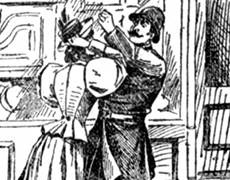
Hatpins were more than long pins used to hold hats in place. Women of the past used them as weapons when confronted by burglars or random male flirts (called Mashers).
In this article, we are going to take a look at some old newspaper articles about hatpins and how they were used for self defense.
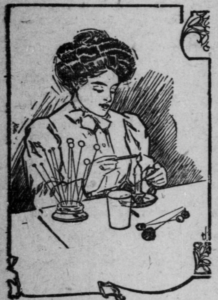
1. Hatpins Better than Pistols
According to the following snippet published in 1908, women were not the greatest with guns, but they apparently could scare off burglars with hatpins:
“The successful efforts of a St. Louis school teacher to repel a footpad by the use of hatpins, finally driving the robber away, bearing a portion of one in his face, once again proves that the hatpin must supersede all other means of feminine self-protection. Pistols in the hands of women have always been ineffective and unreliable. Few women – or men, for that matter – can aim with accuracy and without confusion. Woman is at her best in hand-to-hand conflict, and the weapons with which she is armed must be those peculiarly suited to her mode of combat.” [Source: The Idaho scimitar. (Boise, Idaho), 21 March 1908.]
2. Police Dread Hatpins
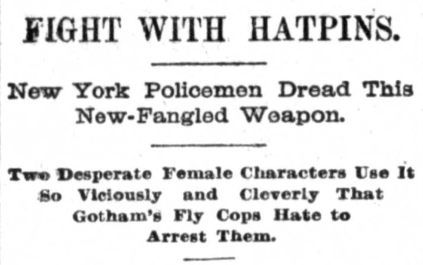
This next article, published in 1897 is a gem of a find. It tells how New York City police dreaded hatpins and two hatpin women in particular.
“The metropolitan police fear the slender, insignificant hatpin more than they do pistols, shotguns, knives, dynamite, or Roosevelt.
“‘Hatpin Mary’ and ‘Hatpin Liz’ are names which are comparatively new in police annals, but already their mention suggests mighty unpleasant business to the bluecoats.
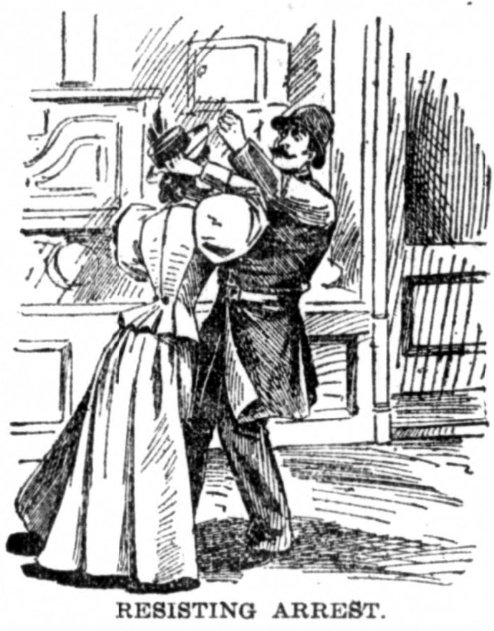
“These women, of course, get their nicknames from the weapon they use in fighting and resisting arrest – the hatpin – which they have demonstrated may be made a most formidable weapon. It can be snatched from the hat and thrust into the person more unexpectedly than any other stabbing implement, and the long, slender steel pin is sure to penetrate deep, causing an ugly wound at best.
“Mary McGovern is the real name of the woman better known as ‘Hatpin Mary.’ During the past few weeks she has been doing time in the workhouse on account of her latest escapade. Policeman Essig was her victim. He found her on Fortieth Street using vile language and indulging in high-kicking. He took her into custody and successfully resisted all her efforts to gouge out his eyes with her hatpin while on the way to the station house.” [Source: San Antonio daily light. (San Antonio, Tex.), 04 Jan. 1897.]
3. How to Use Hatpin for Self Defense
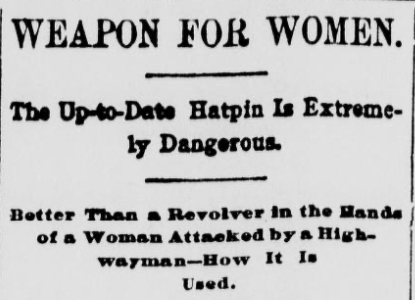
One newspaper in 1904 went as far as to instruct how women could use their hatpins for self defense. Their instructions:
“There are two ways of holding the hatpin. It can be held with the thumb pressed against the top, or with the button grasped in the palm of the hand. In either way it is quite as terrible a weapon as a razor, and one moreover that cannot easily be wrested from the hand that holds it.
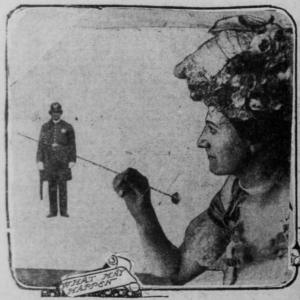
“The method of using [the hatpin] to the best advantage when attacked is to aim at the face of the highwayman. It is not likely that he will wait for the blow. A woman armed with one of these stilettos, even if she has not the slightest idea of the rules of the dagger duello is likely to do more damage in a few seconds than a hungry tiger. The wicked little blade is so small that it is impossible to grasp it to wrench it away from its owner, and yet so keen is it and so light that, used by a woman frenzied by fear, it is likely to be more dangerous to a highwayman than a Gatling gun.” [Source: Heppner gazette. (Heppner, Morrow County, Or.), 23 June 1904.]
4. Better than Screaming
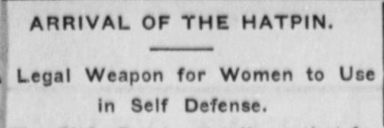
In the following article, published in 1902, it suggests that screaming is part of a woman’s self-defense. However, the hatpin is far better than any yelps in the middle of the night.
“The old-fashioned notion that the only protection of a woman should be her scream has given way to something more practical. A scream is a good thing so far as it goes, but it may not go far enough. A hatpin generally does if handled properly. In extreme cases it should go clear up to the hilt.” [Source: The Daily Ardmoreite. (Ardmore, Okla.), 18 Sept. 1902.]
5. Chicago Street Safe

By 1910, there was a bit of an outcry against hatpins. People, mostly men, stated that hatpins should be considered concealed weapons. Some called for banning hatpins, and a few judges stated that the pointy end of the hatpin should be filed down.
Meanwhile, women in Chicago carried hatpins for protection when walking the streets of Chicago. May E. Davis wrote:
“On behalf of myself and thousands of other women in Chicago who are occasionally on the streets after dark, I want to express an objection which might not appeal to men against the ordinance curtailing the use of hatpins…
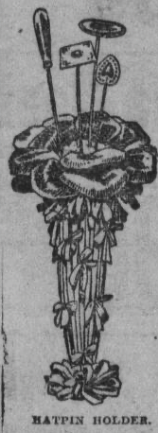
“A hatpin is woman’s weapon of defense. She is no more permitted to carry a revolver or other weapon than is a member of the sterner sex.
“I always feel safe going home late at night with a hatpin available for protection. Before leaving a street car, I always carry a hatpin ready in my hand until I am safe within the door of my home. Many a time it has proved its need. Thousands of other women undoubtedly can speak from their experience of how a stout hatpin has been an effective defense in time of danger. A hatpin is also useful in repelling mashers.” [Source: The Bennington evening banner. (Bennington, Vt.), 04 March 1910.]
6. Mashers

Now, you might be wondering what a masher is. I was when I first heard the term, but then I found this little article about an Omaha judge smashing the mashers and how women were using hatpins to keep the mashers away.
“The following schedule of fines will hold good in this court, regardless of who the mashers are and what their social standing is. For calling a girl ‘a chicken’ the fine will be $5; ‘honey-bunch,’ $10; ‘turtle-dove,’ $15; ‘baby-doll,’ $20, and woe unto the masher that addresses any girl as ‘Little Cutie.’ I’ll give him the limit, $25.”
“That’s Judge Foster’s ‘Masher Schedule,’ and the schedule is not subject to downward revision if the masher happens to be a ‘somebody’ or a ‘somebody’s’ loafing son.
“And the fine is the same whether the ‘mashee’ is a daughter of a laboring man or of a banker.
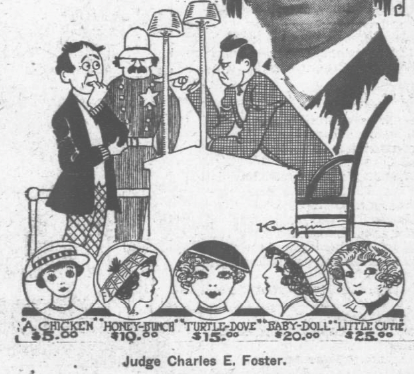
“[Judge Foster’s] ‘Masher Schedule’ went into effect several days ago as the result of a street encounter between a masher and a pretty, athletic, young woman with a leaning toward the militant.
“The masher had followed the young woman from a railroad station and caught up with her at a busy downtown street corner where, after pinching her arm, he informed her that she was ‘some cute chicken.’ The girl, using her hatpin as a weapon, defended herself with several well-directed jabs.
“‘I don’t care who you are or who your father is,’ said Judge Foster when the masher was brought before him. ‘The officer heard you call the girl a chicken. She punished you some and I am going to let you off with a fine of $5.’
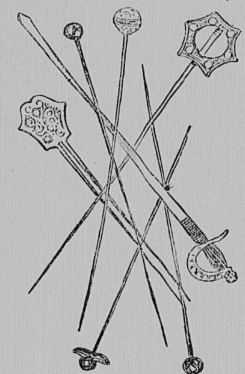
“‘Whenever,’ continued the judge, ‘it comes to a point that respectable women can’t go about their shopping without being annoyed by some pussy-footed masher, it will be because the police haven’t followed my instructions to fetch in all the street-corner male beauties, who, if their guilt is proven beyond a doubt, will find that this court is here to see that good women can be upon the downtown streets without being annoyed.'” [Source: The day book. (Chicago, Ill.), 13 May 1913.]

